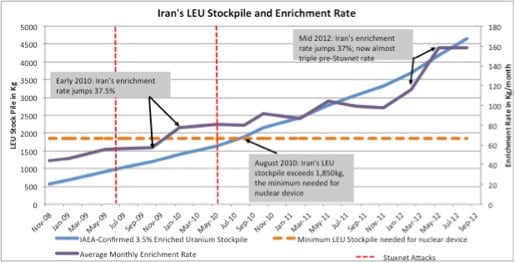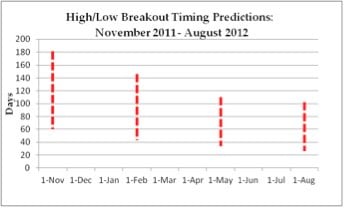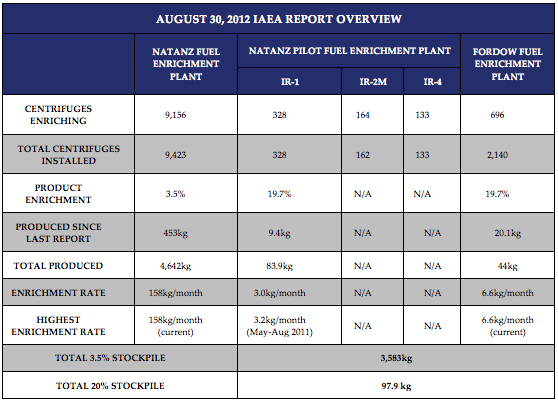Update on Iran’s Nuclear Program
Summary
Despite six months of negotiations and the implementation of tough new international banking and energy sanctions, Iran has continued to dramatically advance its nuclear program. The latest report by inspectors from the International Atomic Energy Agency (IAEA), released today, shows that in every measure Iran has either reached new highs or continues operating at the highest levels previously recorded.* Most disturbingly, Iran continues to accelerate its production of 20% enriched uranium ? the production rate jumped 15% between May and August 2012 ? and is on track to stockpile enough of it for a nuclear weapon (with further enrichment) by February 2013.
Surge in Enrichment Rate and Output
Production rate of 20% enriched uranium jumps 15%, highest level ever. – Total (Fordow + Natanz) 20% enriched production rate: 9.6 kg/month;
- Fastest previous rate (May 2012): 8.4 kg/month;
- 2011 average: 2.6 kg/month;
- 2010 average: 2.3 kg/month.
– Total (Fordow + Natanz) 20% enriched stockpile: 97.9kg.
- This is enough to fuel Tehran Research Reactor for at least 10 years.**
- Minimum 20% enriched uranium needed for nuclear device: 155 kg.
Production of 3.5% enriched uranium remains at all time high level, triple pre-Stuxnet rate.*** – Between May 2012 and Aug. 2012, Iran produced average of 158kg/month.
- Same rate as between Feb. and May 2012;
- Fastest previous rate (Feb. 2012): 115kg/month;
- 2010 average: 83 kg/month;
- 2009 average: 56 kg/month.
– Known 3.5% enriched uranium stockpile reaches 3,583kg; can fuel nuclear reactor. Enough, when enriched to 90%, for two nuclear weapons. Highest number of centrifuges ever operating and installed at Natanz.
- 9,156 centrifuges being fed uranium, most ever;
- 9,423 centrifuges installed total;
- At least 3,772 additional centrifuges in process of installation.
Expansion of Fordow facility continues; 70% complete.
- Number of operating centrifuges still at 696;
- Number of installed centrifuges doubles: up to 2,140 from 1,064 in May 2012, foreshadowing future increases in rate of production.
- Facility designed to hold about 3,000 centrifuges total.
Iranian Defiance Continues
Iran continues to deny IAEA inspectors access to suspected explosives testing site at Parchin.
- Meanwhile, satellite imagery suggests ongoing cleanup efforts at the site, suggesting even if granted access the IAEA will not be able to fully reconstruct what Iran was doing there.
Effect on Timing
As a result of these developments, the time Iran would need to produce enough fissile material for a nuclear weapon continues to fall: – Depending on the method used, Iran could produce 20 kilograms of highly enriched uranium, enough for a weapon, between 26 and 102 days. ****
- In November 2011, that range was between 60 and 180 days.
– That window could fall to just 8 days by February 2013.*****
“They’re doing it better and better, and nothing seems to suggest that either the economic sanctions or the sanctions aimed at preventing them from getting nuclear materials have been thwarting them.” — Blaise Misztal in The Los Angeles Times
BPC Recommendations
Iran is already dangerously close to becoming a nuclear weapon-capable state, and it is imperative that the United States act to stop the clock. To meet this most pressing national security challenge, the Bipartisan Policy Center Iran Task Force released a February 2012 report, Meeting the Challenge: Stopping the Clock, co-chaired by former Senator Charles Robb and General (ret.) Charles Wald, calling for a robust and comprehensive triple-track strategy involving the simultaneous pursuit of diplomacy, sanctions, and visible, credible preparations for a military option. Additionally, the task force has released several white papers further detailing specific elements of this strategy, including: mechanisms to assess the effectiveness of sanctions; principles for negotiating diplomatically with Iran; and specific elements of visible, credible preparations for a military option.



For larger versions of the tables below, please click here.




* As of latest IAEA report: “Implementation of the NPT Safeguards Agreement and relevant provisions of Security Council resolutions in the Islamic Republic of Iran,” Board of Governors Report, International Atomic Energy Agency, August 30, 2012 (GOV/2012/37)
** Iran claims that it needs to produce 20% enriched uranium in order to be able to power the Tehran Research Reactor, which is used to produce radioactive isotopes for medical purposes.
*** For enrichment, uranium must be in gas form as uranium hexafluoride (UF6). The IAEA reports its data in kilograms of UF6. However, for this paper, we will refer to solid form uranium. One kilogram of UF6 yields roughly 0.67kg uranium metal. *
*** This range depends on whether Iran uses a two- or three-step batch recycling process to produce highly enriched uranium for a nuclear weapon and is based upon the work of Greg Jones at the Nonproliferation Policy Education Center. Both scenarios assume the use of the Natanz Fuel Enrichment Plant at its current production rate and drawing upon Iran’s current stockpiles of 3.5% and 20% enriched uranium. For a more detailed explanation, see here.
***** If Iran continues to produce 20% enriched uranium at its current rate, by February 2013 it will have stockpiled 155kg, the minimum needed to produce HEU for a nuclear weapon.
Share
Read Next
Support Research Like This
With your support, BPC can continue to fund important research like this by combining the best ideas from both parties to promote health, security, and opportunity for all Americans.
Give Now